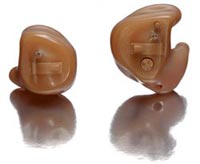Interview with Matt Anderson, Manager, Technical Support, Interton
Share:
Topic: Interton IQ Wireless MultiCROS Hearing System
 CAROLYN SMAKA: Today I'm speaking with Matt Anderson from Interton. Matt, welcome to AudiologyOnline.
CAROLYN SMAKA: Today I'm speaking with Matt Anderson from Interton. Matt, welcome to AudiologyOnline.MATT ANDERSON: Thank you. Thanks for having me.
SMAKA: It's my pleasure. Before we get into our topic today, Interton's IQ Wireless MultiCROS hearing system, would you tell me about your background and what you do for Interton?
ANDERSON: Yes. I'm an audiologist and I currently manage the technical support group at Interton. I graduated from Northwestern University in Chicago in the mid '90s. After my CFY, I went to work in the hearing aid industry. For the past 13 years, I've worked for various companies, supporting audiologists and hearing instruments specialists in terms of hearing aid fittings and computer issues. I worked most recently with ReSound before coming to Interton.
SMAKA: Excellent. Let's talk about the Interton IQ Wireless MultiCROS hearing system. Is this product available for ordering?
ANDERSON: Yes. It's available in an ITE ITE option and a BTE BTE option. As far as I know, we are the only company that offers an ITE-ITE with this kind of product.

SMAKA: What patients are candidates for this technology?
ANDERSON: The IQ Wireless MultiCROS hearing system is a solution for single sided deafness (SSD). So, to determine if a patient is a candidate for this solution, you need to look at the audiogram. If, after testing the patient, you determine that one ear is unaidable, the patient may be a candidate for this solution. In terms of audiological test results, this may mean someone with a corner audiogram in the poorer ear, where a high power BTE fitting for that ear hasn't been effective or satisfactory. Or, it may be someone with a bilateral hearing loss where one ear has very, very poor word recognition, who does worse in tests of binaural discrimination than unilaterally with the good ear alone. You don't want to aid the poorer ear if it significantly worsens overall discrimination ability. An IQ Wireless MultiCROS hearing system in this case would enable the patient to maintain a sense of direction and help the patient to localize sounds.
Another patient to consider a candidate for this system is one who has a hearing loss and a medical condition in one ear that contraindicates the use of traditional amplification for that ear. For example, a patient with severe chronic otitis externa who can't wear a regular hearing aid may be able to wear a IQ Wireless MultiCROS BTE. On the transmitter side, the BTE would be worn over the ear with nothing going in to the ear canal, and this would enable the patient to hear sounds coming from that side.
In regard to the better ear in any of these cases, it could have normal hearing or up to a severe hearing loss. The IQ Wireless MultiCROS can be fit as a regular hearing aid, a CROS or a BiCROS. The BTE product has a 120 dB output and 55 peak gain;the ITE product has a 112 output and 45 peak gain, so they both fit a wide range of hearing losses.
SMAKA: What types of issues do people with SSD present with clinically that motivate them to use amplification?
ANDERSON: Most of the time it is localization issues. This can be frustrating, disorienting and even contribute to safety issues, i.e. crossing the street. And of course people with SSD have difficulty hearing the signal presented to the poorer ear. For people whose right ears are unaidable, communicating while driving is difficult. Let's say the husband has an unaidable right ear and is usually does the driving, he'll have a hard time hearing his wife in the passenger side or other passengers in the back seat of the car. There are many other situations as well where people really want the input from both ears. Understanding speech in noise may also be difficult for people with SSD. I make the analogy that trying to understand speech in noise with SSD is like trying to read with one eye instead of two. It's a lot more difficult and it's tiring. When you have input from both sides, it's definitely much easier.
SMAKA: Matt, you mentioned that Interton's IQ Wireless MultiCROS hearing system can be fit as a CROS, a BiCROS, and a hearing aid. Can you review these types and when professionals would fit each one?
ANDERSON: Sure. As you know, CROS is an acronym, one of the many acronyms we have in audiology [laughs].
SMAKA: [laughs]
ANDERSON: CROS stands for Contralateral Routing of Signal. That means taking the signal from the poorer ear to the better ear without amplifying it in the better ear. In the case of a CROS fitting, the good ear has normal hearing, or essentially normal where no amplification is needed. BiCROS stands for Bilateral Contralateral Routing of Signal. That means taking the signal from the poorer side to the good side, and amplifying it. BiCROS fittings are appropriate when the poorer ear is unaidable, and the better ear has a hearing loss that needs to be accounted for with amplification.
The IQ Wireless MultiCROS is an extremely flexible solution, and in addition to CROS and BiCROS, includes what we call monaural mode. This mode can be selected by the professional to operate all the time or in one of the listening programs. In monaural mode, the instrument acts just like a regular hearing aid, without also receiving the signal from the poorer ear (transmitter) side.
The reason we call it this system a MultiCROS is because it can operate in any one of these modes in any program. For example, in Program 1, it could be CROS, in Program 2 it could be BiCROS, and in Program 3 it could be monaural. Any combination of mode and program is possible;the professional can program as needed for each individual patient.
SMAKA: So if a patient is initially fit with a CROS fitting, but the better ear gets worse and needs amplification, the system can simply be re-programmed?
ANDERSON: Exactly. That's another benefit of the flexibility of this device. You can change to CROS or BiCROS at any time. You're not burning anything permanent into the chip;you can change those features at any time.
SMAKA: Also, if a patient is wearing it, say, as a BiCROS, and she leaves the transmitter home, it still functions as a hearing aid?
ANDERSON: Yes. The professional would need to program one program in monaural mode, so the system wasn't searching for an FM signal from the transmitter in cases like this. Then, when the patient isn't wearing the transmitter, he or she could simply put the instrument in this program and wear it as a hearing aid without any interference caused by searching for an FM signal.
This is another advantage of our system. In addition to offering a wireless ITE-ITE system, our system doesn't have the type of interference issues that some other products on the market have.
SMAKA: Why is that?
ANDERSON: We have a small designated transmission range, and we can make slight adjustments within that range if someone were having any issues with radio interference. And, in a situation where a patient may have radio interference, with our system you can switch into monaural mode and eliminate the interference.
SMAKA: In the old days we had CROS and BiCROS system with wires running between the units. Your system is wireless.
ANDERSON: Yes, it is wireless, both the BTE-BTE and ITE - ITE systems. Being wireless makes this system much more cosmetically appealing. Additionally, with a wireless system you have better integrity of the system over the long term. This is because with day-to-day wear and use you don't have jacks and wires that can get dirty, broken, clogged with hairspray or any of the other sorts of things that can contribute to making the system not work.
SMAKA: CROS and BiCROS fittings aren't something that most professionals see every day in the clinic. What do they need to know or think about going into these fittings?
ANDERSON: I'm glad you brought up that point. At Interton, we know that CROS and BiCROS are not fittings you do every day. It might only be once or twice a year that you see someone with this specific kind of need. So, our technical support team is more than happy to walk professionals through these fittings, provide a refresher training over the telephone, or answer any questions at all. We encourage professionals to please call us - we are here to support your fittings and help to make them a success.
A common technical question we get is regarding the programming system. This product was designed to be programmed via NOAHlink. It will program with HI-PRO, but it requires one simple adjustment to do so.
If you attach the IQ Wireless MultiCROS to a HI-PRO box and the hearing aid is set in a CROS or BiCROS mode, the HI-PRO box will form a loop with the device, it will cause interference and the patient will hear static. The necessary adjustment in this case is to set the instrument to monaural mode while it's connected to the HI-PRO, and this will enable you to make any kind of programming adjustments needed without interference. When you're finished with programming adjustments, before exiting the software, you just go back and select CROS or BiCROS, whichever is desired. Again, this is only needed with HI-PRO;with NOAHlink, there's no interference and therefore no adjustment to the programming process is needed.
Another thing I'd like to mention is that we have a brochure available for professionals called the Interton IQ Wireless MultiCROS Technical Brochure. It's a new piece and it's very comprehensive - it includes all the technical specifications, a step-by-step fitting guide, and a FAQ section. It's a one-stop shop for ordering and fitting this product. It's a great resource in addition to our technical support team to support these fittings.
SMAKA: Is the IQ Wireless MultiCROS available to the VA?
ANDERSON: Yes. In the VA system, they see a lot of patients with single sided deafness because of the nature of working with the military - gun shots or loud noises may occur on one side.
SMAKA: What do your customers tell you about their experiences fitting this product?
ANDERSON: They're happy with the product. A lot of folks are happy that we can change the transmission range if they have interference. And customers tell me they're happy because they have satisfied patients, who don't need to keep returning to the clinic for programming adjustments.
There are some patients even still today out there in the old wired CROS and BiCROS systems. And a lot are moving over to our wireless system. We have the flexibility in the software to change fitting algorithms - professionals can choose between DSL, NAL-NL1 and our proprietary algorithm, Dynafit. The patients moving over to our wireless system have been doing really well.
Another great thing we're hearing is regarding telephone use. We know as audiologists that phone use is often difficult for patients, especially those wearing a BiCROS configuration because the better ear has a hearing loss. With the IQ Wireless MultiCROS, patients may not need to use the telecoil or a specific phone program on the better ear in these cases. The patient simply has to hold the phone up to the poorer ear. It's not intuitive at first, because these patients are used to holding the telephone to their better ears. With this system, however, the transmitter on the poorer ear will send the telephone signal to the better ear without feedback and without the patient having to deal with switching to a telecoil. When patients hold the phone up to their poorer ear, it works really, really well.
SMAKA: Of course, but I would never think of that, Matt!
ANDERSON: That's exactly the reaction I have with our customers when I tell them. They're like, "Wow, yeah, that's right!"
SMAKA: The IQ Wireless MultiCROS has a lot of new technology like feedback cancellation. Can you cover some of the features?
ANDERSON: Yes. To start with, it has expansion or what is sometimes called microphone noise reduction. As you mentioned, there's also a feedback manager with two options - phase cancellation and an adaptive notch, depending on whether you have the feedback manager set on low or high. The high setting includes both the adaptive notch and phase cancellation.
It has three channel, 14 band signal processing so you can adjust gain in up to 14 different bands. You can change the compression ratios in the low, mid and high channels. It also has a very flexible compression system in terms of kneepoints (from 42 - 66) and attack and release times.
There's also a programmable volume control that allows you to change gain reserve. There are audible tones that have programmable frequency and intensities and a smart start feature so that the professional can program a delayed onset.
SMAKA: What about battery drain?
ANDERSON: The drain for the receiver side is about 2 mA and the drain for the transmitter side is 1 mA. So, when the battery is going dead on the receiver side, the transmitter is still going strong. Generally, we recommend keeping it simple and changing the batteries in both the receiver and transmitter at the same time. For many patients that makes things easier. There is a low battery warning for the receiver side, not the transmitter side.
SMAKA: That makes sense. What size batteries are used?
ANDERSON: The ITE-ITE uses a 312 battery which makes for a nice low profile in the ear. In addition, we need to have at least five millimeters spacing between the coil that acts as the FM receiver and the battery or it just won't work, so a 312 battery gives us that space. The BTE-BTE uses a 13 battery. For a 13 battery, the battery life should be about seven days and for the 312 battery, somewhere in the neighborhood of four to five.
SMAKA: Gotcha. Anything professionals need to know in terms of ordering?
ANDERSON: We just need the audiogram, and for ITE-ITE we need impressions of course. We prefer to get both the right and left ear audiometric data for record keeping sake. Just tell us you want the IQ Wireless Multi CROS and give us the audiogram, that's it.
SMAKA: Any special recommendations in terms of earmolds for CROS fittings?
ANDERSON: With CROS fittings, the better ear has normal hearing, so you want the most non occluding mold you can get. So, any kind of open skeleton mold is probably a good general recommendation. Another option is a flex mold - it looks like a hollowed out canal style mold and it's a really good non-occluding option.
SMAKA: And on the transmitter side, what keeps it in place?
ANDERSON: It's a standard BTE case. What I would do is just order an open skeleton mold or flex mold on that side. Just so you can keep the ear open.
We have a full earmold lab in house, so customers can order the earmolds from us, and if they have any questions about earmolds they can call us as well.
SMAKA: Well, thanks Matt. It was nice talking with you and we wish you much success with the IQ Wireless MultiCROS - it looks like a flexible and innovative solution.
ANDERSON: Thank you for having me.

For more information about Interton and the IQ Wireless MultiCROS hearing system, visit interton.com/e/index.html or the Interton Web Channel at Audiology Online. You can also call Interton at 1-800-247-4741.

